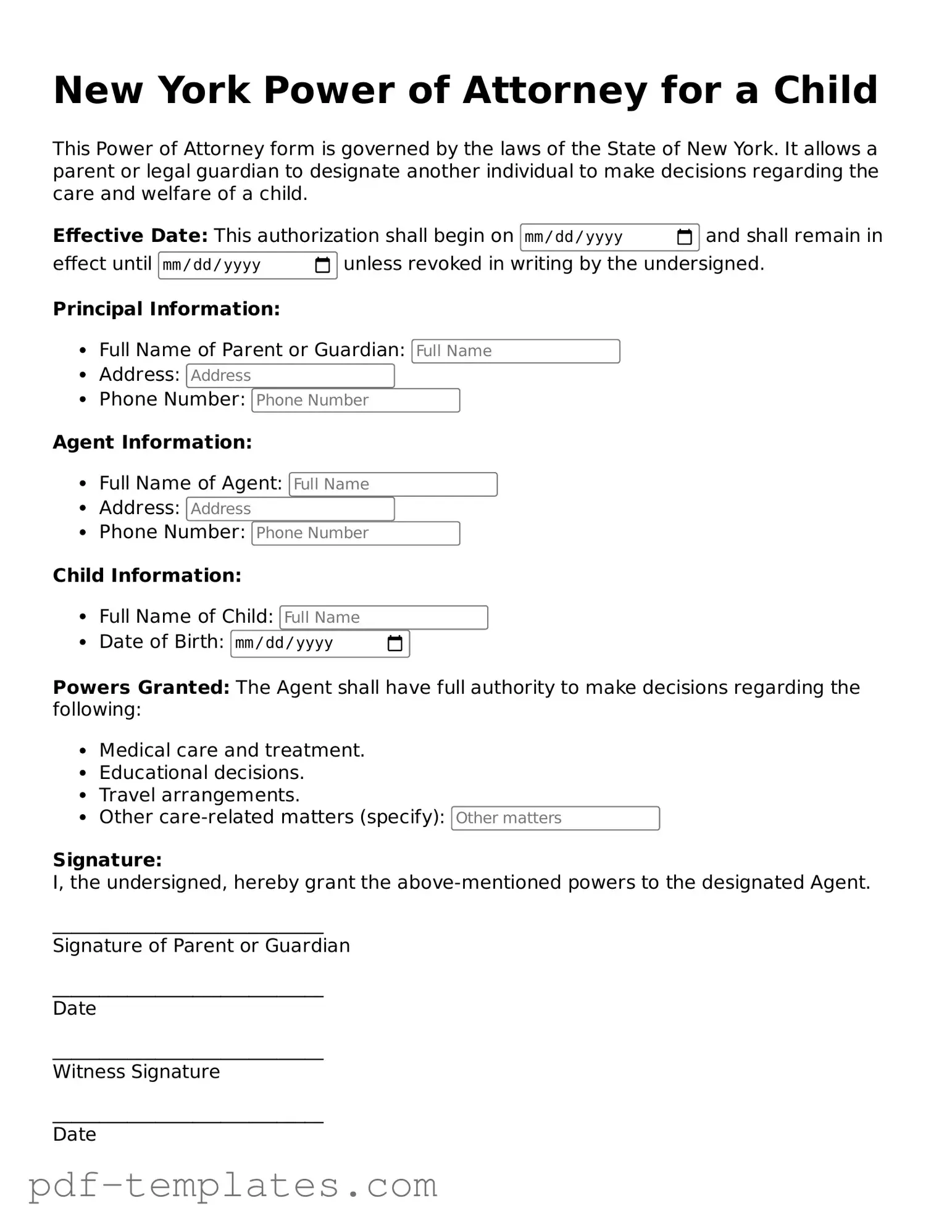The New York Power of Attorney for a Child form shares similarities with a standard Power of Attorney document. Both forms allow an individual to designate another person to act on their behalf. In the case of the Power of Attorney for a Child, the focus is specifically on the authority granted for decisions related to a minor. This ensures that a trusted adult can make important decisions regarding the child’s welfare, education, and healthcare when the parent or guardian is unavailable.
Another similar document is the Child Custody Agreement. This legal form outlines the arrangements for the care and custody of a child between parents or guardians. Like the Power of Attorney for a Child, it emphasizes the best interests of the child. Both documents are designed to provide clarity and security in situations where parental involvement may be limited or absent.
The Temporary Guardianship form also bears resemblance to the Power of Attorney for a Child. It allows a parent or legal guardian to appoint someone else to care for their child for a limited time. This form ensures that the child’s needs are met while the parent is temporarily unable to fulfill their responsibilities. Both documents prioritize the child's safety and well-being during transitions or emergencies.
The Medical Authorization form is another document that serves a similar purpose. It grants permission for a designated individual to make medical decisions for a child in the event that the parent cannot be reached. This is crucial in emergencies where timely medical care is necessary. Like the Power of Attorney for a Child, it ensures that a trusted adult can act in the child's best interests regarding health-related matters.
The Child Care Agreement is comparable as well. This document outlines the terms under which one person agrees to care for a child, including responsibilities and expectations. Similar to the Power of Attorney for a Child, it formalizes the arrangement and clarifies the roles of each party involved in the child's care, promoting stability and security for the child.
Next, the Adoption Agreement shares some similarities. While it involves a more permanent arrangement, both documents address the legal responsibilities of caring for a child. The Adoption Agreement formalizes the transfer of parental rights, while the Power of Attorney for a Child temporarily delegates those rights for specific purposes, ensuring that the child's needs are met regardless of the situation.
The Child Support Agreement is another relevant document. While it primarily focuses on financial responsibilities, it is often created in conjunction with custody and guardianship arrangements. Both documents aim to ensure that a child's needs are met, whether through care or financial support, highlighting the importance of stability in the child's life.
The Special Needs Trust is also worth mentioning. This document is designed to manage assets for a child with special needs, ensuring they receive necessary care without jeopardizing government benefits. Like the Power of Attorney for a Child, it emphasizes the importance of planning for a child's future and ensuring their ongoing welfare.
The Consent to Travel form is similar in that it allows a designated adult to take a child out of state or country. This document ensures that there are no legal issues when traveling, especially if the child is not traveling with a parent. It complements the Power of Attorney for a Child by providing additional legal backing for travel arrangements.
In the realm of legal documents pertaining to child care and custodial arrangements, understanding the nuances of each form is crucial, and resources like the Trailer Bill of Sale can be beneficial when looking for clear documentation; for more details, you can visit https://documentonline.org/blank-trailer-bill-of-sale.
Lastly, the Educational Power of Attorney is relevant. This document allows a parent to delegate decision-making authority regarding a child's education to another adult. Like the Power of Attorney for a Child, it focuses on the child’s best interests and ensures that someone trusted can advocate for the child's educational needs when the parent is not available.
